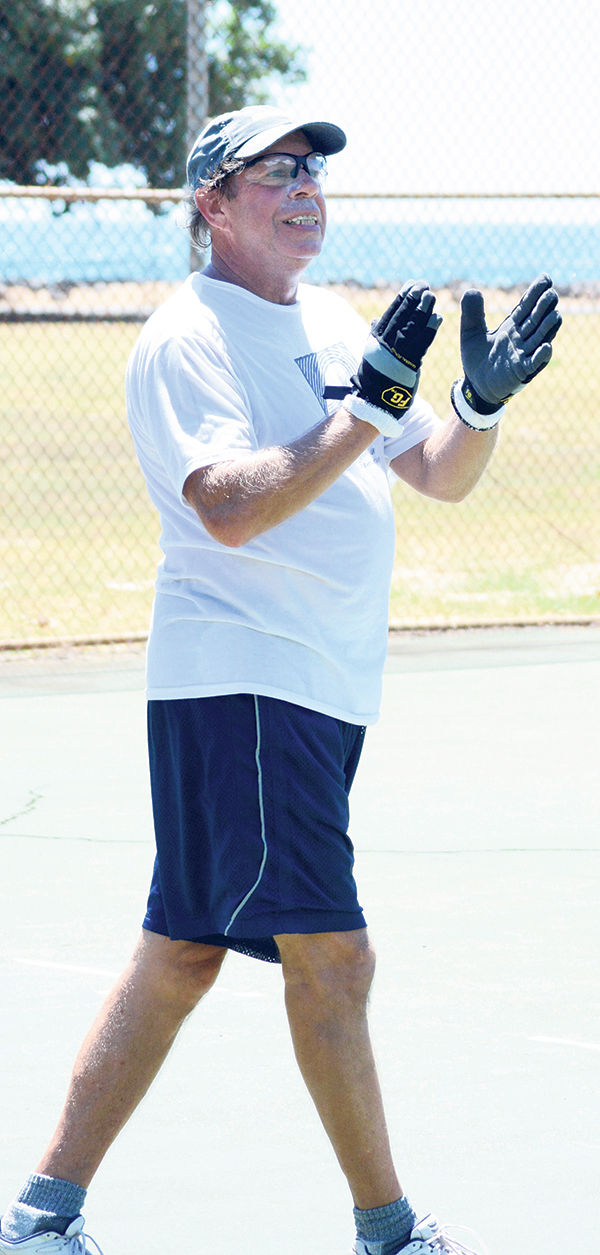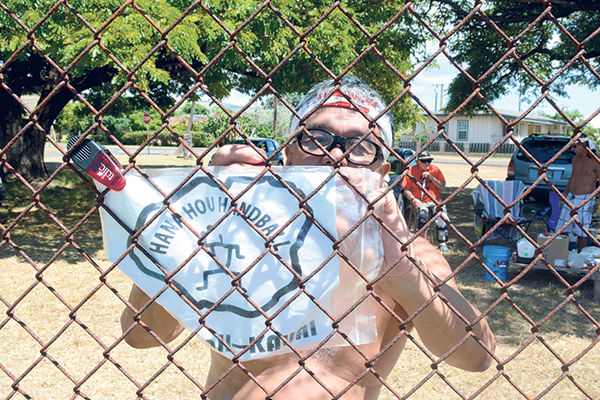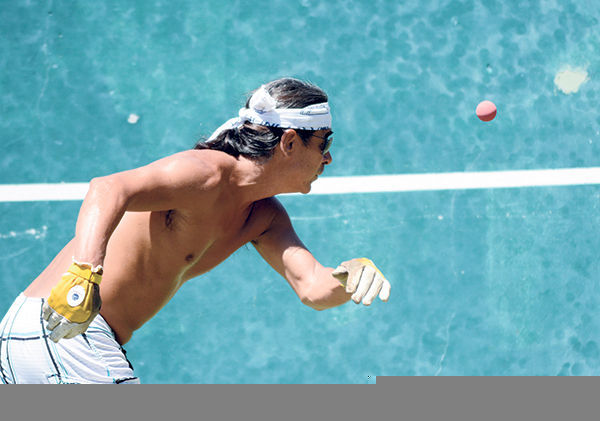It’s Sunday afternoon, around 90 degrees at Kekaha park, but it feels hotter. The air is thick and heavy and it seems like the only logical thing to be doing here would be sitting in the shade, relaxing and enjoying
It’s Sunday afternoon, around 90 degrees at Kekaha park, but it feels hotter. The air is thick and heavy and it seems like the only logical thing to be doing here would be sitting in the shade, relaxing and enjoying a beverage.
But no one ever said handball players were completely logical.
Instead of kicking back and watching football in an air conditioned home, four men are battling on the handball court under a relentless sun. It’s a doubles match, and Bogart Kealoha and Robert Zelkovsky are taking on Nestor Figueroa and Armand Mora.
They crash chasing shots on a pavement that hurts to touch because it’s so hot. They run, leap, reach, stretch, dive, tumble and swat at the small, red ball that bounces off the 12-foot high wall. When Zelkovsky rips a winning kill shot, Mora holds out his hand for a congratulatory slap. When Kealoha mishits a return, he mutters in frustration, “Ah, Bogie!” When Figueroa rips a cross-court winner, he smiles ever so slightly.
Finally, after much back and forth and shots from left and right hands, near and far, on this afternoon, the team of Zelkovsky and Kealoha prevail, 21-12. The men exchange handshakes as they exit the court and head for their seats in the shade of a tree.
“We were just lucky to hold on and take the victory,” Zelkovsky says.
A few minutes later, they’re recovering with food and drink. They’ve been at this since mid-morning and now, it’s mid-afternoon. That’s about four hours of handball. Sweat clings to their skin, their clothes, even their gloves hanging on the chain link fence. A breeze comes in and cools them for a few moments.
Kealoha takes a deep breath and begins to unlace his shoes. Enough.
“I’m done,” he says.
The heat, he adds, doesn’t bother him.
“I kind of like it. I’d rather play in hot like this than an AC court,” he says.
Mora looks over.
“I’m ready to play. I see he’s taking off his socks now, so that means we’re done,” he says, grinning.
But they’ll be back.
Next Sunday, same time, same place, to fight for points and games. It’s competitive, yes. But they’re friends, so camaraderie is even more important than who has bragging rights for a week. These guys, an over age 50 bunch, have been slugging it out on this worn court ever since Kauai Athletic Club closed its racquetball and handball courts in the summer of 2012. Sometimes, there’s five or six. Others, eight or 10 might show up. If there’s enough players, there’s action on both courts. The weather doesn’t keep them away from their weekly gathering — even when the heat and humidity are almost overwhelming and heatstroke seems imminent.
“Handball players are unique,” Zelkovsky says. “They’re a few degrees off center.”
They play to win, demonstrated by the dives and yells and tumbles that go on each game, but they help and encourage each other, too.
“We just get mad at ourselves for missing easy shots,” Zelkovsky said.
Play, refuel, recharge, rotate in new players, create teams, and go again. So it goes, for hours on any given Sunday. Some days, they hang out until sunset, talking story and admiring an ocean view.
“You’re able to rehydrate and continue to play,” Mora says. “Otherwise, you’d probably faint.”
Sometimes, kids stop, watch and learn. Neighbors occasionally check out the action.
The group is a mix of veteran handballers. Some played in college. Some have competed in national tournaments. A few are looking ahead to the first Honolulu doubles handball tournament in November. Others are new to the sport, or at least new to this group. Figueroa joined earlier this year.
“The last couple months I’ve been here, I lost 10 pounds right away,” he says, showing off a flat belly.
Mora has been playing handball since he was a boy, when he learned the sport from his father.
“His left hand is probably better than my right,” Zelkovsky said. “He’s really good.”
Both Figueroa and Zelkovsky played handball in Brooklyn.
“It’s like bringing back all the good memories of all the good times I had playing handball and getting together, meeting new people. It’s been great fun,” he said.
Then there’s Curly Carswell, a college football star at Stanford in the 1950s who later opened Kauai Athletic Club, encouraged the growth of handball on the island and used to play handball competitively. To do well at handball, he says, requires hand-to-eye coordination, footwork, anticipation and quick reflexes.
These days, with another recent knee surgery, the court is off-limits. So the man referred to as “The Godfather” wears a hat and sunglasses and watches from the sideline and offers advice, wit, wisdom and the occasional jab, too.
“I listen to them crying,” he says.
Handball used to be a main event on Kauai, with annual tournaments and fundraisers. Some years, hundreds of players would register. But with no public indoor court, the number of dedicated handball players has declined to a handful, about 20, who love to compete and even travel to Oahu for the state handball games.
There’s an outdoor handball court in the Wailua Homesteads, but tennis players are usually there, so to avoid any conflicts, the handball folks carpool and take their game to Kekaha, where sunny weather is almost guaranteed, they have the court to themselves and it’s easy to get warmed up.
One wall is tougher than a four-wall, indoor game, more of a hit or miss deal. There’s no catching it off the back wall bounce, no hopes for even a lucky bounce. It’s a game of speed, accuracy and endurance. The margin for error is reduced when the ball is flying at 40 to 50 mph and you’ve got one chance at a return.
“We compromise and adapt to it because that’s all we have,” said Clay Hiramoto, veteran handball player.
They travel far to reach Kekaha. Carswell comes from Hanalei. Figueroa, from Kilauea. Mora and Zelkovsky, from Wailua and Kealoha from Puhi.
It’s a tight-knit fraternity with a desire to stay in shape, to remain young in heart, mind and body, that unites them.
Kealoha, a pilot, credits the game and his father for maintaining a muscled upper body, his strength and speed through the years.
“It’s all in the genes,” he says.
Kekaha handball is described as a great social mixer, open to any and all. Newcomers are encouraged to join them — just bring some food and drink to share between games.
All that’s really needed, points out Zelkovsky, is a ball and a wall. Gloves, goggles and tennis shoes complete the equipment. Cost is minimal. It’s that simplicity of handball he loves, much like when he played stickball as a kid.
“It’s a great sport,” Figueroa says.
A perfect way to spend a Sunday.




